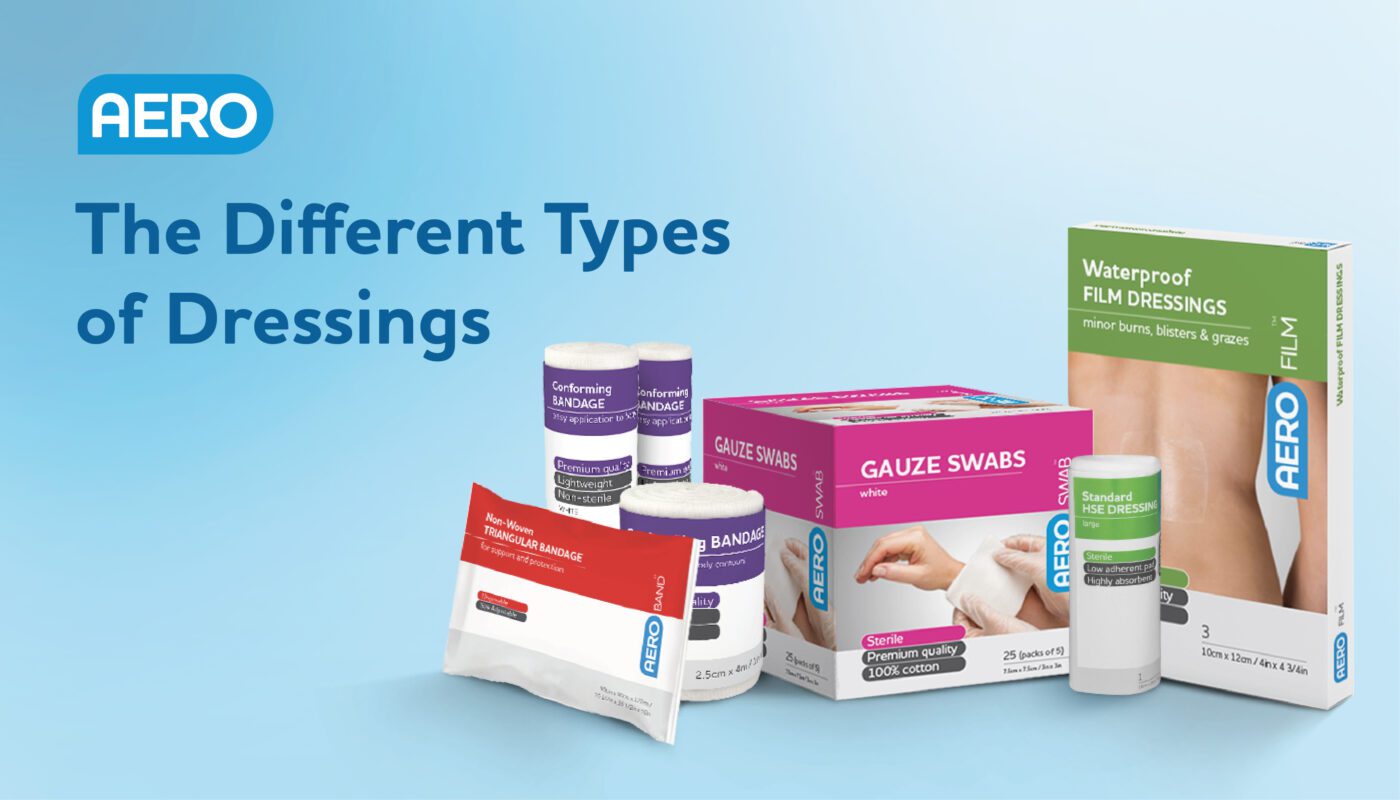News
6 types of wound dressings and how to use them
Published 12/04/2023
Dressings are staple parts of a first aid kit, but are all dressings necessary for your use? We walk you through the different types to save you time elsewhere.
Dressings are staple parts of a first aid kit, but are all dressings necessary for your use?
When it comes to wound care, it can be hard to know where to start. As a first aid manager, you want the right equipment for the health and safety requirements within your workplace. But finding the correct first aid consumables can be tiresome and confusing, especially when presented with a range of products that all look similar at first glance.
For many, the easy, but not necessarily best, option is to purchase an off-the-shelf first aid kit that houses a range of dressings. Although it’s not the right decision, it’s an obvious choice to meet the basic HSE (Health and Safety Executive) requirements. Unfortunately, this often leaves you with bulk items you’ll never use or low-quality products, and money wasted in the process. Simply put, you need something like-for-like.
Differentiating between the different types of wound dressings, and understanding your industry’s requirements, could support you in the long run.
What are the different types of wound dressings?
With HSE requirements, and a market saturated with untrustworthy products, first aid managers have a tough job when it comes to procuring suitable wound care. Your workplace first aid kit will need to include a solution for wound care, ensuring all needs are covered. But, what’s the difference?
Gauze
Most commonly used to treat grazes or surface wounds that break the skin, gauze is an excellent solution for cleaning or protecting injuries. Around 30% of workplace injuries are caused by slips, trips and falls, which can lead to a surface wound requiring first aid.
When to use a gauze wound dressing
- As a sterile solution for an infected wound, or wound susceptible to infection
- In the instance that wounds required extra support or padding, especially around sensitive areas
- Where frequent and regular dressing changes are required, this could be for fresh wounds or to keep surgical wounds clean
- For injuries that are oozing or bleeding and need an extra layer to absorb bodily fluids
HSE Dressings
Every workplace first aid kit must include some form of HSE-compliant first aid kit. It’s likely that as part of this, you’ll also receive an HSE dressing that can be used to secure non-adhesive pads or to protect delicate areas of skin. These multifunctional dressings can also be used for compression, elevation or support. Medium and large HSE dressings are often the best choices as they can cater to a range of body shapes and sizes.
When to use an HSE wound dressing
- To fix or secure a non-adhesive pad in place
- To support aching or sore joints from strain injuries
- To protect wounds and areas of delicate skin from being knocked or broken
Burns Dressing
Where gauze absorbs moisture and bodily fluid, a burns dressing does the opposite. Burn treatments and dressings are commonplace within a range of industry-approved HSE first aid kits. These are especially relevant for the catering and hospitality sector as well as industrial-based professions. Designed to intentionally add moisture to an injury, the dressing supports wounds that need extra support in healing. Fortunately, these dressings are suitable for shallow and deep skin traumas, and can soothe pain around burn sites.
When to use a burns wound dressing
- For the treatment around excessively dry wounds or skin traumas
- To assist with controlling wound infection
- In the instance that wounds are surrounded by frail skin or dead tissue
Triangular bandage
Triangular bandages are a staple within any first aid kit. In fact, their design means they can be used in a range of scenarios for varying levels of support. As well as securing sore limbs, such as an arm, in a steady position, triangular bandages can also be used as a makeshift compression bandage and to support fragile joints. Additionally, where a tourniquet is not present, triangular bandages can provide a solution for incredibly heavy bleeds.
When to use a triangular bandage
- For the protection of fragile joints and limbs
- To support wounds requiring compression
- Assist with stemming major bleeds
Transparent film
The transparent film dressing acts as a window so medical professionals can see the progress of the wound without disturbing the skin. This film is designed to align with the contours of the body, making it comfortable and flexible for wearers. Transparent film won’t typically be included in a workplace first aid kit.
When to use a transparent film dressing
- For the purpose of observing a wound without disturbing the skin around the area
- To protect burns, cuts and abrasions from bacteria
- Around surgical stitches or incisions that are healing
Foam
These wound dressings keep moisture in and bacteria out, whilst ensuring there is no snagging on the wound. Foam dressings also supply some of the most comfort when it comes to dressing changes, as no debris is left around the wound and the pads are designed for additional absorbency.
When to use a foam dressing
- For wounds that continue to weep and require additional absorbency
- To protect sore areas of skin with an additional cushioning
- For sensitive wounds that can easily be damaged
Why do organisations need different types of wound dressings?
- To cover varying health and safety criteria, such as possible hazards
- To meet industry-specific requirements, including food safety
- To provide care for all injuries pre-empted on the risk assessment
- To accommodate the number of employees and visitors
- To support those with various skin complaints and allergies
- To treat a range of wound sizes and needs
What are the best types of dressings for your first aid kit?
At the end of the day, you want an HSE-compliant first aid kit that contains all the correct parts, nothing less. A first aid supplier, like us at Aero Healthcare, will be able to determine the correct products you need based on your organisation and accompanying risk assessments. Using first aid requirements based on industry-related risks and hazards ensures you are as equipped as possible if an incident occurs. From the information collected within risk assessments, you’ll be able to determine the best types of dressings to keep workers, visitors and the public safe.
Many factors, including industry-specific requirements, will determine the types of dressings you need within your first aid kit. Certain regulations or legislation might affect a need, for example. Alternatively, other forms of dressings, bandages and plasters could be redundant and wasted. We’ve identified two very different sectors that have their own complex needs and risk assessments to manage. This highlights some of the most supportive choices from our Aero range.
Construction and Industrial Professions:
- Burn dressings are ideal, especially when dealing with heat-expelling machinery and tools. The cool protective gel helps to reduce discomfort around the burn site.
- Finger dressings are vital to your workplace first aid kit, particularly with numerous sharp objects and machinery that could cause a crush injury.
Food and Beverage Industry, including catering and manufacturing:
- Dealing with a lot of heat from boiling water and metal surfaces requires suitable first aid to deal with burns. Although great care is taken, burn gels and dressings offer catering workers an immediate solution.
- Damage from sharp objects, such as knives, should also be remedied with a high-quality dressing that offers absorbency and comfort whilst further medical action is taken.
Need the right dressings for your first aid kit? Speak to Aero Healthcare
Our dressing selection is designed to fit industry requirements, whilst also ensuring HSE compliance is met. At Aero Healthcare, we remove the time-consuming phase of first aid sourcing by listening to your exact needs and offering up products that are relevant and fit for purpose.
Additionally, our Surefill™ solution makes refilling your first aid kit easy. Rather than purchasing a new case every time and wasting plastic, SurefillTM can simply be slipped into your existing first aid kit with all the correct products you need. For even greater convenience, you only need to manage one expiry date on your first aid kit, which reduces the need to manually check all the products within your kit.

Share this article

